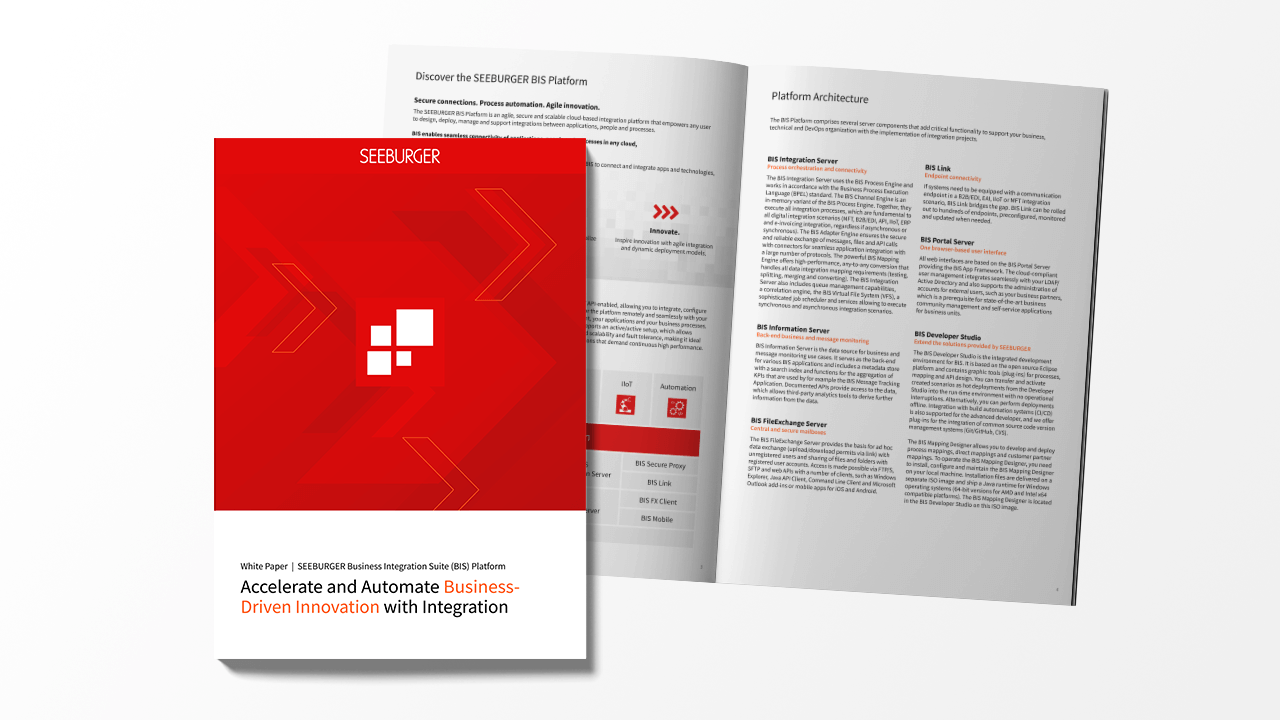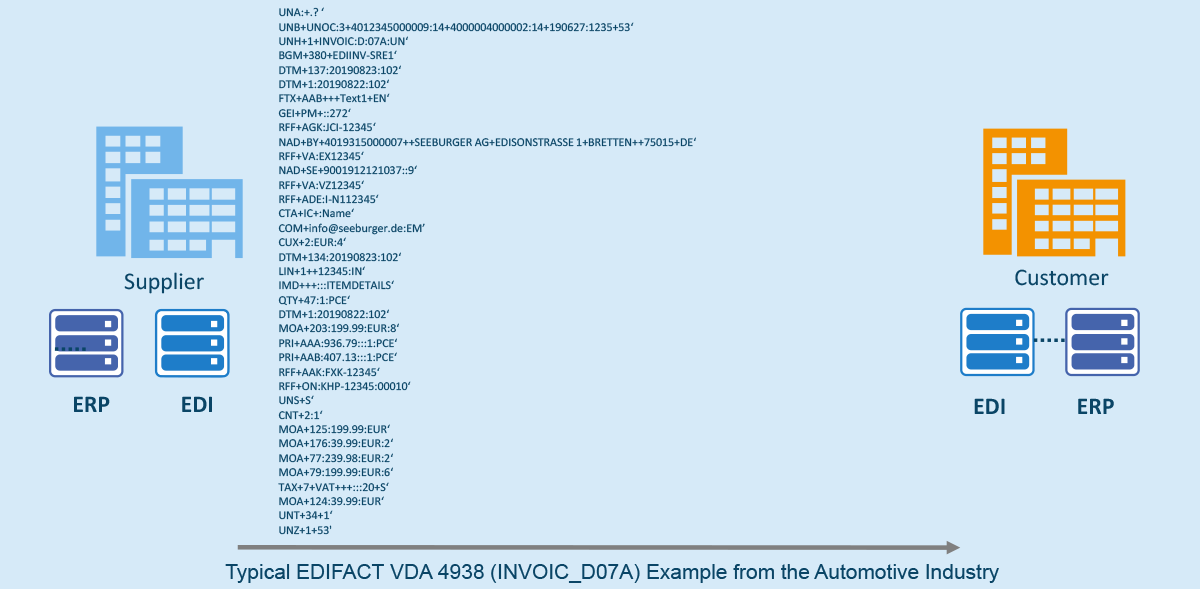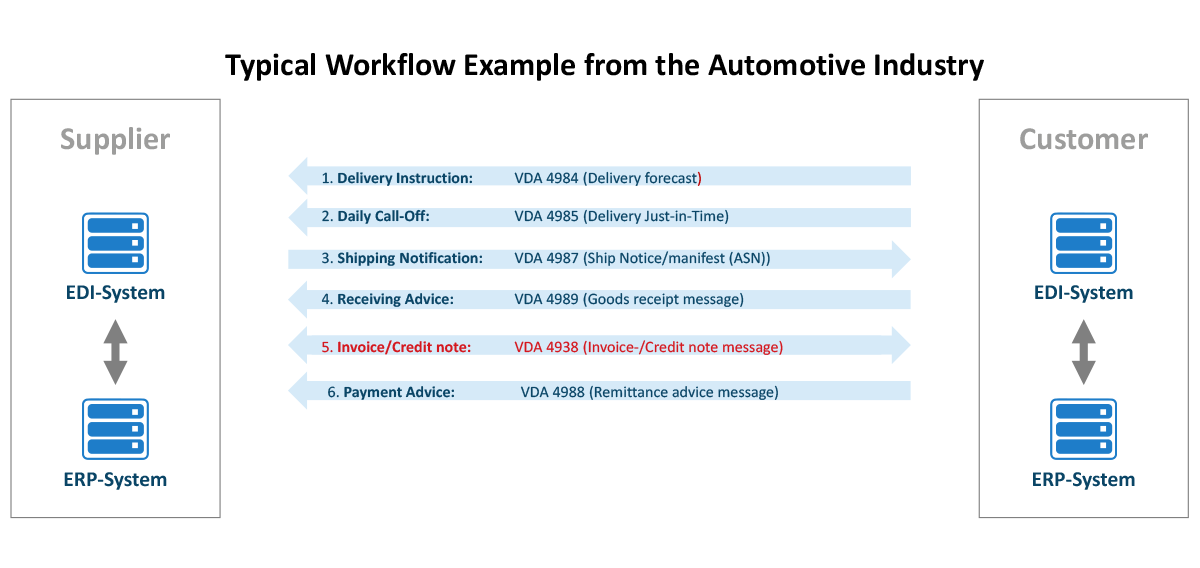
What is a VDA 4938 Message?
1. Executive Summary
The VDA 4938 is also references as VDA Global Invoice and is used to exchange invoice data as well as credit note data. Therefore invoice data is sent from supplier to customer and credit note data is sent the other way around from customer to supplier using the VDA 4938 format.
The VDA 4938 format is based on EDIFACT (D.07A Version) and as such is a subset of the EDIFACT INVOIC specially designed for the automotive processes.
2. The use of the VDA 4938 Message
Partners can use the VDA 4938 message in order to automatically exchange invoicing information and to directly align the billings against the representative orders. Therefore the VDA 4938 message consists of segments containing billing information for the exchanged materials/services and information about sender and recipient. By that the VDA 4938 message is designed to replace the paper-based invoice when partners communicate via EDI.
As the VDA 4938 format is used in various scenarios the VDA has split the description in 4 parts:
- Part 1: Process framework documentation explaining the process in general
- Part 2: Global INVOIC Application guidance explaining the structure and segments of a VDA 4938 message
- Part 3: Electronic invoice exchange with small and medium-sized companies describing how the process can be implemented with such companies
- Part 4: Data structure for the exchange of invoicing data for transport services describing a standardized exchange of invoice data for such partners

3. How does a typical VDA 4938 structure look like?
The VDA 4938 guideline specifies the segments and elements which need to be used to properly built-up a VDA 4938 message. EDI solutions – which can either be an on premises solution or EDI Cloud Service – send, receive and process EDI messages like VDA 4938. To ensure a high quality of the electronic invoice process it is mandatory to follow the VDA 4938 standards.
A typical VDA 4938 Message includes:
- Invoice-/Credit note number
- Invoice-/Credit note date
- Reference to shipment (date of shipment of the single items)
- Terms of payment
- The actual items that are charged or credited
- Surcharges/discounts

4. Processing of the VDA 4938 message as an invoice
The VDA 4938 message is generated by the supplier and sent to the customer when it is meant to be used as an invoice. The receiving system on customer side validates the message against VDA 4938 specifications and sends back a functional acknowledgement after successful reception. The functional acknowledgement confirms the reception of the invoice message to the supplier. Next the VDA 4938 data will be forwarded to the customer’s ERP system where it will show up as new invoice record.
5. Processing of the VDA 4938 message as a credit note
In case the VDA 4938 is used as credit note the customer will prepare the credit note data on his end and send it via a VDA 4938 message. Then the message will be received and validated by the supplier’s system before it is forwarded to its ERP system. There the credit note data is aligned against the shipments that are referenced in the VDA 4938 message.
VDA 4938 and VDA 4988 messages
Based on the financial processes definition it is possible that a VDA 4988 message is sent as follow up document on the VDA 4938 message from the customer (buyer) to the supplier (payee). The VDA 4988 message or Payment Advice contains further instruction how the payment is performed. This information helps the suppliers to reconcile payments they receive against invoices they have issued.
EDI workflow for processing of the VDA 4938 message
In general the documents which are exchanged between EDI trading partners follow a typical sequence of business processes, which depends on the type of industry. The figures below shows the role of the VDA 4938 standard and which other message types are used in an automotive scenario:

6. How is the VDA 4938 format called in other EDI message standards?
The VDA 4938 standard defines a format widely used in automotive industries as an EDIFACT Subset. In the EU and ASIA in other industries like CPG or retail the EDIFACT INVOIC standard is very common to exchange invoice data.
The ANSI X12 810 format on the other hand is widely used in the NAFTA region for the same purpose.
7. Typical errors when using the VDA 4938 message
Common problems that appear when exchanging invoice messages are based on wrong or missing data. If data is transmitted inside a VDA 4938 message that is unknown in the supplier’s or customer’s ERP system, an error on the processing step will be the result. Typical issues in context of VDA 4938 messages are:
- Parts, regarding delivery or regarding order (missing or wrong reference)
- Prices or price units are missing
- Payee or payer reference is wrong or missing
8. Benefits using EDI and the VDA 4938 message
Benefits exchanging invoice information via VDA 4938 for customer and supplier
9. Conclusion: Automate the VDA 4938 message with flexible operating models
Today EDI solutions need to run stable, cost-efficient and with flexibility. For your next generation EDI solution consider operate EDI on your own premises, or booking it as an EDI Cloud Service in the SEEBURGER Cloud or run the EDI solution in public cloud environments like the ones from Google, Azure, AWS etc.









